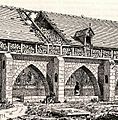Danse Macabre facts for kids

The Dance of Death (also known as French: Danse Macabre, Italian: Danza Macabra, or German: Totentanz) is a special kind of allegory that became popular in the Middle Ages. It's a way of showing that everyone, no matter how rich or poor, powerful or weak, will eventually die. Death treats everyone the same.
Contents
What is the Dance of Death?
The Dance of Death is usually shown as a line of people from all walks of life, like kings, popes, knights, and peasants. Each person is dancing with a skeleton or a figure of Death. This imagery reminds everyone that death is universal and unavoidable. It was a common theme in art, literature, and even plays during the late Middle Ages.
Why was it created?
This idea became very popular after big events like the Black Death (a terrible plague) in the 14th century. So many people died that it made everyone think a lot about death. The Dance of Death helped people understand and cope with the idea that life is short and death can come for anyone at any time. It was a way to teach people about the importance of living a good life.
How was it shown?
You could find the Dance of Death in many places:
- Murals: Painted on the walls of churches and cemeteries.
- Books: Illustrated in books, often with poems or stories.
- Plays: Performed as part of plays or street performances.
Common Characters
In these scenes, Death often leads a procession of people. The characters usually include:
- A King or Queen
- A Pope or Bishop
- A Knight or Soldier
- A Merchant
- A Peasant or Farmer
- A Child
Each character shows a different part of society. Death takes them all away, showing that no one can escape.
Famous Examples
One of the most famous examples is a series of woodcuts by the artist Hans Holbein the Younger. His "Dance of Death" series from the 16th century is very detailed and powerful. It shows Death interacting with people in their everyday lives, not just leading them in a dance.
Other famous examples include:
- The mural at the Holy Innocents' Cemetery in Paris, painted in the 15th century.
- Frescoes in churches across Europe, like in Hrastovlje, Slovenia, and Beram, Croatia.
These artworks served as a strong reminder for people to think about their lives and prepare for death. They were not meant to scare people, but to make them reflect on their actions and faith.
Images for kids
-
Johannes de Castua: Detail of the Dance Macabre fresco (1490) in the Holy Trinity Church in Hrastovlje, Slovenia
See also
 In Spanish: Danza de la Muerte para niños
In Spanish: Danza de la Muerte para niños











